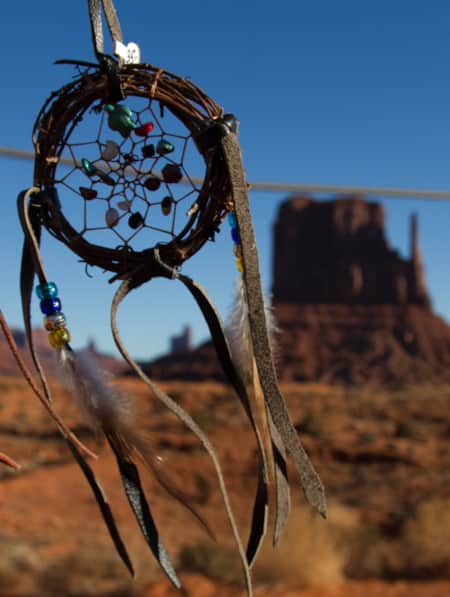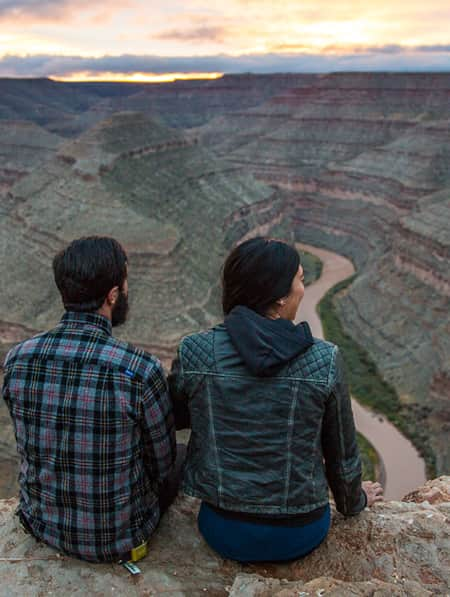
Valley of the Gods
Drive the Scenic Byway
The Valley of Gods is perhaps best experienced by driving the 17-mile scenic Valley of The Gods Loop that traces the valley’s floor. During dry weather, the road is easily driven with a passenger vehicle; however, you may need a 4X4 during and after rains – always check the weather report before planning a visit. Several tall, red, isolated mesas, buttes and cliffs tower above the valley floor, which you’ll see while driving along the gravel road. For 250 million years, water, wind and ice carved the formations in the Cedar Mesa sandstone to create this spectacular desert landscape. There is hiking throughout the Valley of the Gods, but it’s more of an exploration in cross-country meandering, as there are no established trails. Park at the base of whichever rock structure you like and walk about; you might even find some beaten paths from other walkers, making traversing through the sand less difficult. The Bureau of Land Management (BLM) manages the land, and there are no services in the Valley of the Gods except for a bed and breakfast near the western entrance.
Valley of the Gods is perfect for auto tourists looking for a quiet backroad and more adventurous travelers looking to explore grand open landscapes — just come prepared with plenty of water, sun protection and a good plan.
Why It’s Worth Visiting
The Valley of the Gods area is one of the best, and most underrated, areas in Southern Utah. Largely due to its lack of developed hiking trails and other amenities, it's a fun place to escape the crowds and see the finer things that Canyon Country offers. The sandstone formations are unique here and similar to those in Monument Valley. These cool monolithic rocks have intriguing names, including Setting Hen Butte, Rooster Butte, Seven Sailors Butte, De Gaulle and His Troops, and Lady in the Bathtub, to name a few of the nearly dozen listed in tourist literature.
You can begin your drive at either the west entrance (Highway 261) or the east (Highway 163), and the direction of travel isn’t important. You can leave the car and explore at any location (park at pull-offs) as you drive. Because it’s BLM land, no travel restrictions or permits are required, like at Monument Valley. Without established trails at this special place, roam freely and walk amongst the gods — the famous red dirt and richly colored formations beg for it.
The vantage while driving on the highway to the west of the park at sunrise is rather breathtaking, as the monolithic sandstone monuments are silhouetted with the rising sun. The deep desert hues of big, bold skies juxtaposed next to even bolder rock structures roaming freely among sage with the gods all around you; laughing as you try to name the formations yourself.
Things to Do
-
Drive the Moki Dugway
You can extend your scenic backroad adventure by continuing onto the Moki Dugway Scenic Backway — a remarkable drive that weaves through Southern Utah’s desert landscapes via exposed switchbacks on towering cliff walls. It is so close by that it offers panoramic views of the Valley of the Gods; this dugway makes for a great addition to an area itinerary. Drivers should note the route does include steep, unpaved and sharp switchbacks, so it may not be for the faint of heart.
-
Hiking
There is hiking throughout the Valley of the Gods, but it’s more of an exploration in cross-country meandering, as there are no established trails. Park at the base of whichever rock structure you like and walk about; you might even find some beaten paths from other walkers, making traversing through the sand less difficult.
-
Off-Roading
The Valley of the Gods road can be considered a mild off-roading trail, but the surrounding areas offer world-class off-roading experiences. Off-road travel is not allowed in the Valley of the Gods area, but Southern Utah is an excellent hub for accessing off-roading trails of all difficulty levels.
-
Spot Rock Formations
The Valley of the Gods’ unique geological formations are worth marveling at. While exploring the sandstone valley, see if you can spot some famous rock formations — Rooster Butte, Lady in a Tub, Setting Hen Butte, Castle Butte, Seven Sailor’s Butte and more.
GPS Coordinates, Parking and Regulations
- GPS Coordinates to the west entrance: (37.264275, -109.932515)
- No off-road travel is allowed. Previously impacted sites (away from ponds and corrals) permit dispersed camping. No campfires are allowed in Valley of the Gods. Dogs are allowed.
- Park at any of the designated pull-offs.
- If you’re looking for other accommodations, lodging options in Mexican Hat include a bed and breakfast, lodge, motel, an RV park and two inns.
Best Time of Year to Visit
Valley of the Gods is open year-round. The best times to visit are spring (March to early June) and fall (September to October). Summer months can become oppressively hot, and are right in the middle of monsoon season. For the best view of saturated red rock and deep-hued blue skies, visit the park at sunset or sunrise. When wet, the roads through Valley of the Gods might become impassible, so take caution and check the weather forecast before venturing out.






